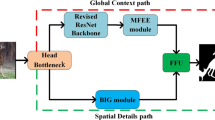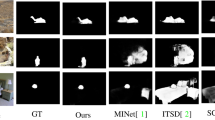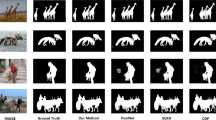Abstract
With the explosive growth of image data, image processing becomes more and more important. Salient object detection is one of the important research directions in image processing. At present, a variety of research methods have been used to detect salient objects, but the low-level features used by traditional salient detection methods are not robust to complex scenes. Fully Convolutional Network (FCN) shows good performance in image processing, but there are some shortcomings such as the ambiguous edge of salient object detection. To solve the problem of boundary fuzzy, a multi-objective salient detection method combining FCN and ESP (Efficient Spatial Pyramid) modules is proposed, which also uses different jump connection methods to obtain more low-level features to accurately define the boundary of multi-objective salient objects. In the experiment, we use the MITSceneParsing dataset to train and test the model. Compared with the related models in accuracy and MIOU, the results show that the improved network has higher accuracy and more accurate boundary information while ensuring that the processing time of the model does not increase.






Similar content being viewed by others
References
Cheng M, Niloy J et al (2014) Global contrast based salient region detection. IEEE Trans Pattern Anal Mach Intell 37(3):569–582
Erhan D, Szegedy C, Toshev A et al. (2013) Scalable object detection using deep neural networks. In IEEE Conference on Computer Vision and Pattern Recognition, pp 2155–2162
Fareed et al (2015) Salient region detection through sparse reconstruction and graph-based ranking. J Vis Commun Image Rep 32:144–155
He R, Lau W, Liu W et al (2015) SuperCNN: a Superpixelwise convolutional neural network for salient object detection. Int J Comput Vis 115(3):330–344
Itti L, Koch C, Niebur E (1998) A model of saliency-based visual attention for rapid scene analysis. IEEE Trans Pattern Anal Mach Intell 20(11):1254–1259
Krizhevsky A, Sutskever I, Hinton G (2017) ImageNet classification with deep convolutional neural networks In NIPS. pp 84–90
Lecun Y, Bottou L (1998) Gradient-based learning applied to document recognition. Proc IEEE 86(11):2278–2324
Ling B, Yu L, Li S (2019) Multi-task image semantic segmentation based on convolutional neural network. Radio Eng 49(7):575–580
Liu N, Han J (2016) DHSNet: deep hierarchical saliency network for salient object detection. In IEEE Conference on Computer Vision and Pattern Recognition, pp 678–686
Liu T, Yuan Z, Sun J, Wang J, Zheng N, Tang X, Shum HY (2011) Learning to detect a salient object. IEEE Trans Pattern Anal Mach Intell 33(2):353–367
Long J, Shelhamer E, Darrell T (2015) Fully convolutional networks for semantic segmentation. In IEEE Conference on Computer Vision & Pattern Recognition, pp 640–651
Long et al (2017) Fully convolutional networks for semantic segmentation. IEEE Trans Pattern Anal Mach Intell 39(4):640–651
Mehta S, Rastegari M, Caspi A, Shapiro L, Hajishirzi H (2018) ESPNet: efficient spatial pyramid of dilated convolutions for semantic segmentation. Proceedings of the European Conference on Computer Vision (ECCV), pp 552–568
Peng Y (2018) Research on recognition algorithms based on unmanned aerial vehicle image. Harbin Engineering University
Wang T, Borji A, Zhang L et al (2017) A stagewise refinement model for detecting salient objects in images. In IEEE International Conference on Computer Vision, pp 4019–4028
Wang L, Lu H, Ruan X et al. (2015) Deep networks for saliency detection via local estimation and global search. In IEEE Conference on Computer Vision and Pattern Recognition, pp 3183–3192
Wang X, Ma H, Chen X (2016) Salient object detection via fast R-CNN and low-level cues. In International Conference on Image Processing IEEE, pp 1042–1046
Wang L, Wang L, Lu H et al (2016) Saliency detection with recurrent fully convolutional networks. In European Conference on Computer Vision, pp 825–841
Wang W, Xu J, Li Y (2019) An improved image super-resolution method based on convolution neural network. Comput Appl Soft 36(3):214–218
Wang Y, Zhang H, Huang H (2019) A survey of image semantic segmentation algorithms based on deep learning. Appl Electr Tech 45(6):23–27
Acknowledgements
Upon completion of this paper, the authors would like to express their deep gratitude to those who provided help and made practical contributions to this paper. Thanks to Ms. Feng Shu for her support during the experiment of the paper. Not only that, Ms. Feng Shu also participated in the grammar correction and image drawing of the paper in the revision of the paper. Here, the authors express their heartfelt thanks.
Funding
This work was supported by the National Natural Science Foundation of China under Grant 61502262.
Author information
Authors and Affiliations
Corresponding author
Additional information
Publisher’s note
Springer Nature remains neutral with regard to jurisdictional claims in published maps and institutional affiliations.
Rights and permissions
Springer Nature or its licensor holds exclusive rights to this article under a publishing agreement with the author(s) or other rightsholder(s); author self-archiving of the accepted manuscript version of this article is solely governed by the terms of such publishing agreement and applicable law.
About this article
Cite this article
Zhai, Z., Yao, L., Sun, X. et al. Multi-objective salient detection combining FCN and ESP modules. Multimed Tools Appl 82, 4405–4417 (2023). https://doi.org/10.1007/s11042-022-13607-3
Received:
Revised:
Accepted:
Published:
Issue Date:
DOI: https://doi.org/10.1007/s11042-022-13607-3




